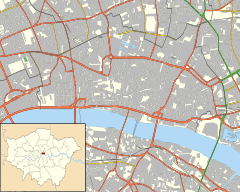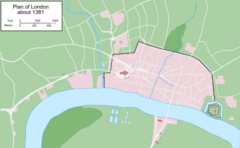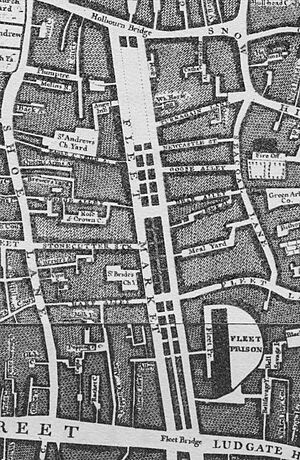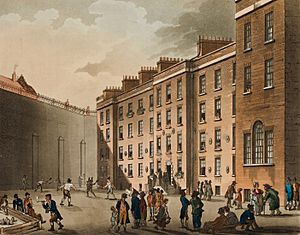Fleet Prison facts for kids
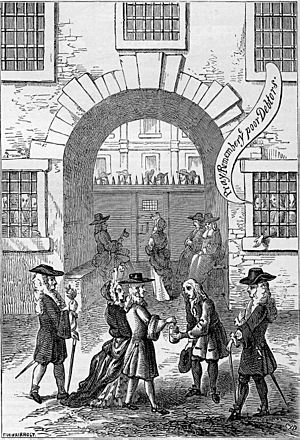
"Pray remember ye poor debtors": inmates of the Fleet Prison beg passers by for alms
|
|
| Coordinates | 51°30′58″N 0°6′18″W / 51.51611°N 0.10500°W |
|---|---|
| Status | Closed |
| Security class | debtor's prison, contemnor's prison |
| Population | 300, plus families |
| Opened | 1197 |
| Closed | 1846 |
| Warden | See below |
| Street address | off Farringdon Street |
| City | London |
| Country |
|
| Notable prisoners | |
| John Donne, Theodore of Corsica | |
The Fleet Prison was a famous prison in London, England. It was located next to the River Fleet, which is how it got its name. The prison was first built in 1197. It was rebuilt several times over the centuries. The Fleet Prison was used for a very long time, finally closing in 1844. It was completely taken down in 1846.
Contents
History of Fleet Prison
The Fleet Prison was built in 1197 near what is now Farringdon Street. It was named after the nearby River Fleet. This prison became well-known for holding people sent there by the Star Chamber. The Star Chamber was a special court that dealt with serious crimes against the king.
Who Was Imprisoned Here?
Later, the Fleet Prison was mainly used as a debtor's prison. This meant people who couldn't pay their debts were sent there. It also held people who had shown "contempt of court." This means they had disobeyed a judge's orders from the Court of Chancery.
In 1381, during the Peasants' Revolt, the prison was deliberately destroyed. Wat Tyler's followers burned it down.
During the 1400s, most prisoners were there for money problems, not for violent crimes. At that time, it was thought to be more comfortable than Ludgate Prison. However, prisoners had to pay for their rooms and food. They also had to give tips to the prison staff. There was even a fee to enter and leave the prison.
Some cells were quite nice, like private rooms. But very poor prisoners sometimes slept two to a bed. The poorest inmates would beg for money through a special grate in the prison wall. They would ask people passing by for help.
Fires and Rebuilding
In 1666, the prison burned down during the Great Fire of London. Prisoners had to escape at the last moment. After the fire, the prison's warden, Sir Jeremy Whichcote, bought another building to house the debtors. He then rebuilt the Fleet Prison on its original spot using his own money.
By the 1700s, the Fleet Prison mostly held people who owed money. It usually had about 300 prisoners, and their families often lived with them. Like the Marshalsea prison, it had two main parts. The "common side" was very strict and hard to live in. The "master's side" was more open, but you had to pay rent to stay there.
Prisons as Businesses
Back then, prisons were run like businesses to make money. Prisoners had to pay for everything, including food and lodging. There were fees for things like unlocking doors or taking off chains. The Fleet Prison had the highest fees in England.
There was a special grille built into the prison wall on Farringdon Street. This allowed prisoners to beg for money from people walking by.
Interestingly, prisoners didn't always have to live inside the prison itself. If they paid the warden enough money, they could rent rooms outside the prison walls. This area was called the "Liberty of the Fleet" or the "Rules of the Fleet." Many secret Fleet Marriages also took place in this area starting in 1613. The Liberty of the Fleet covered areas like Ludgate Hill and Fleet Lane.
Bad Wardens
The person in charge of the prison was called the warden. This job was often "farmed out" to the person who offered the most money. This system made the prison famous for its cruel treatment of prisoners.
One warden, Thomas Bambridge, who took over in 1728, was especially cruel. He was known for demanding huge amounts of money from prisoners. A committee from the House of Commons investigated him. They found that he would unfairly put prisoners in chains and throw them into dungeons. He treated them in a very mean and illegal way.
Because of his actions, Bambridge was sent to Newgate Prison. A special law, the Warden of Fleet Prison Act 1728, was passed. This law stopped him from ever being a warden again.
Final Closure
In 1780, during the Gordon Riots, the Fleet Prison was destroyed again. It was rebuilt between 1781 and 1782.
Finally, in 1842, a new law was passed. Prisoners from the Fleet, Marshalsea, and Queen's Bench prisons were all moved to the Queen's Prison. The Fleet Prison was then closed. In 1844, it was sold to the Corporation of the City of London. They tore it down in 1846.
The demolition produced a lot of building materials, like three million bricks. After being empty for 17 years, the land was sold to a railway company. It became the site of the new Ludgate station.
Wardens of the Fleet Prison
- Roger de Saperton; active in 1381
- Elizabeth Venour (around 1460s)
- Edmund Haslewood (died 1548)
- John Haslewood (died 1550)
- Edward Tyrrell (born 1545)
- Sir Robert Tyrrell (born 1582)
- Thomas Babington
- Sir Jeremy Whichcote (warden from 1660)
- Sir William Babington
- Thomas Bambridge; active in 1728
Famous People Imprisoned Here
Many interesting people were held at Fleet Prison over the years.
- In 1601, the famous poet John Donne was imprisoned. This happened after he secretly married Anne More without her father's permission. He was held until his marriage was proven legal. The priest who married them and the witness were also imprisoned.
- Samuel Byrom, the son of writer John Byrom, was imprisoned for debt in 1725. In 1729, he wrote a letter to a powerful friend, the Duke of Dorset. In his letter, he complained about how unfair the prison system was. He wrote that other countries treated debtors kindly, but England was harsh. He said that even if debtors could pay their original debts, they were often kept in prison for other fees. He described how wardens would put prisoners in chains, throw them into dungeons, and demand high prices for food. He believed that if wardens were paid a fair salary and couldn't charge extra fees, prisons would not be so full.
Other notable inmates include:
- Christopher Billopp – A commander in the King's Navy, he died in Fleet Prison in 1725.
- John Cleland – An 18th-century writer who supported freedom of speech.
- Edmund Dummer (1651–1713) – A naval engineer who helped build important docks. He died in Fleet Prison after going bankrupt.
- Sir Richard Grosvenor, 1st Baronet – An ancestor of the Duke of Westminster. He spent almost 10 years in prison because he had promised to pay his brother-in-law's debts if he couldn't.
- Charles Hall – An important thinker about economics and an early socialist.
- John Jones of Gellilyfdy – A Welsh expert on old writings. He used his time in prison (between 1617 and the 1650s) to copy old manuscripts.
- Jørgen Jørgensen – A Danish adventurer who helped start the first settlement in Tasmania. He even ruled Iceland for a short time in 1809. Later, he became a British spy and was sent to Tasmania.
- Richard Hogarth – The father of the famous painter William Hogarth. He was a poor Latin teacher and coffee house owner. He was imprisoned for debt for five years.
- Sir Thomas Lodge – A former Lord Mayor of London. He spent a short time in the Fleet after going bankrupt in 1563.
- Richard Onslow – A future high-ranking lawyer and Speaker of the House of Commons. He was briefly imprisoned after being involved in a fight in 1556.
- William Paget (actor) – An actor and author of "The Humour of the Fleet" (1749).
- John Paston – A 15th-century gentleman known for the Paston Letters. He was imprisoned three separate times.
- William Penn – An early supporter of democracy and religious freedom. He was imprisoned for debt in 1707.
- Moses Pitt – A publisher who wrote The Cry of the Oppressed in 1691. This book was a strong plea for himself and all debtors in prison.
- Elizabeth Thomas (1675 – 1731) – A poet who was imprisoned for debt.
- George Thomson (physician) (around 1619 – 1676) – A doctor and writer who fought in the English Civil War. He was captured and imprisoned here for a time.
- Francis Tregian the Younger – He is thought to have copied musical manuscripts while in prison.
- Theodore von Neuhoff – The only King of Corsica. He was imprisoned in 1756, just before he died.
- Thomas Keyes or Keys (died 1571) – A castle captain and servant to Queen Elizabeth I. He was imprisoned for marrying Lady Mary Grey without the Queen's permission. Lady Mary had a claim to the throne.
In Fiction
The Fleet Prison has appeared in many famous stories:
- Mr. Samuel Pickwick – The main character in Charles Dickens's The Pickwick Papers. He is sent to the Fleet Prison because he refuses to pay fines from a lawsuit. The book gives a very clear picture of life in the prison.
- In Shakespeare's play, Henry IV, Part 2, the character Falstaff is surprised when the new king orders him to be taken to the Fleet Prison.
- In The Luck of Barry Lyndon, the character Lyndon spends his last nineteen years in Fleet Prison.
- Near the end of Pierce Egan's 1821 story Life in London, Bob Logic spends time in Fleet Prison for debt.
- In The Adventures of Peregrine Pickle by Tobias Smollett, Peregrine and his friends end up in Fleet Prison after losing all their money.
- Walter Besant and James Rice's novel The Chaplain of the Fleet (1881) is a historical story that takes place in the Fleet Prison in the 1700s.
See also
- List of demolished buildings and structures in London


